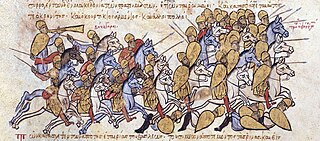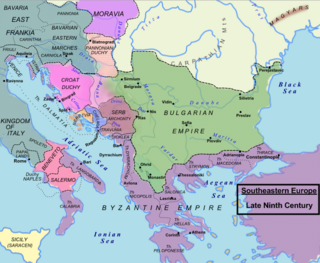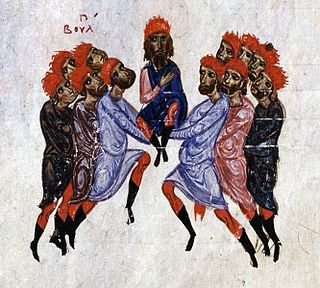 W
WThe Bachkovo Monastery of the Dormition of the Theotokos, archaically the Petritsoni Monastery or Monastery of the Mother of God Petritzonitissa is a major Eastern Orthodox monastery in Southern Bulgaria. It is located on the right bank of the Chepelare River, 189 km from Sofia and 10 km south of Asenovgrad, and is directly subordinate to the Holy Synod of the Bulgarian Orthodox Church. The monastery is known and appreciated for the unique combination of Byzantine, Georgian and Bulgarian culture, united by the common faith.
 W
WThe Bitola inscription is a medieval Bulgarian stone inscription written in the Old Church Slavonic language in the Cyrillic alphabet. Currently, it is located at the Institute and Museum of Bitola, North Macedonia among the permanent exhibitions as a significant epigraphic monument, described as "a marble slab with Cyrillic letters of Ivan Vladislav from 1015/17".
 W
WThe Theme of Bulgaria was a province of the Byzantine Empire established by Emperor Basil II after the conquest of Bulgaria in 1018. Its capital was Skopje and it was governed by a strategos. The local Slavic inhabitants were called by the Byzantines Bulgarians. Nevertheless the Bulgarians kept their nationality, which reached particular strength after the Second Bulgarian Empire was formed in the 12th century. The period ended with the Uprising of Asen and Peter.
 W
WThe Bulgarian–Hungarian wars were a series of conflicts that occurred during the 9th–14th centuries between the Bulgarian Empire and the Kingdom of Hungary. The nearly 500-year conflict encompassed the northern and western Balkans, or what is known today as north-western Serbia, Romania and northern Bulgaria.
 W
WThe First Bulgarian Empire was a medieval Bulgar-Slavic and later Bulgarian state that existed in Southeastern Europe between the 7th and 11th centuries AD. It was founded in 681 when Bulgar tribes led by Asparuh moved to the northeastern Balkans. There they secured Byzantine recognition of their right to settle south of the Danube by defeating – possibly with the help of local South Slavic tribes – the Byzantine army led by Constantine IV. At the height of its power, Bulgaria spread from the Danube Bend to the Black Sea and from the Dnieper River to the Adriatic Sea.
 W
WThe Gate of Trajan or Trajan's Gate is a historic mountain pass near Ihtiman, Bulgaria. It was named so after Roman Emperor Trajan, on whose order a fortress by the name of Stipon was constructed on the hill over the pass, as a symbolic border between the provinces of Thrace and Macedonia.
 W
WThe Battle of Kleidion took place on July 29, 1014, between the Byzantine Empire and the Bulgarian Empire. It was the culmination of the nearly half-century struggle between the Byzantine Emperor Basil II and the Bulgarian Emperor Samuel in the late 10th and early 11th centuries. The result was a decisive Byzantine victory.
 W
WParistrion, or Paradounabon/Paradounabis, which is preferred in official documents, was a Byzantine province covering the southern bank of the Lower Danube in the 11th and 12th centuries.
 W
WThe Battle of Skopje occurred in the vicinity of the city of Skopje in 1004.
 W
WTheophylact was a Byzantine archbishop of Ohrid and commentator on the Bible.
 W
WThe battle of Thessalonica took place in the fall of 1040 near the city of Thessalonica in contemporary Greece between the Bulgarians and the Byzantines. The battle ended with a Byzantine victory.
 W
WThe Uprising of Georgi Voyteh was a Bulgarian uprising against the Byzantine theme of Bulgaria in 1072. It was the second major attempt to restore the Bulgarian Empire after the Uprising of Peter Delyan in 1040-1041.
 W
WThe Uprising of Peter Delyan, which took place in 1040–1041, was a major Bulgarian rebellion against the Byzantine Empire in the Theme of Bulgaria. It was the largest and best-organised attempt to restore the former Bulgarian Empire until the rebellion of Ivan Asen I and Petar IV in 1185.